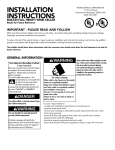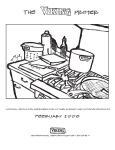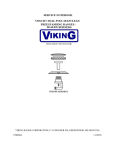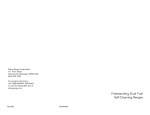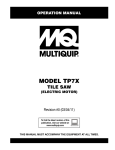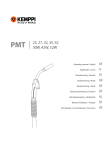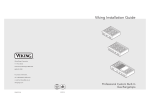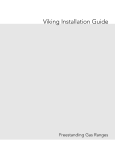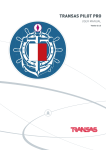Download Viking VDSC305-4B Specifications
Transcript
VIKING RANGE CORPORATION 111 Front Street Greenwood, Mississippi 38930 USA (662) 455-1200 INSTALLATION INSTRUCTIONS DUAL FUEL RANGES IMPORTANT - PLEASE READ AND FOLLOW •Before beginning, please read these instructions completely and carefully. •Do not remove permanently affixed labels, warnings, or plates from the product. This may void the warranty. •Please observe all local and national codes and ordinances. •Please ensure that this product is properly grounded. •The installer should leave these instructions with the consumer who should retain for local inspector’s use and for future reference. Installation must conform with local codes or in the absence of codes, the National Fuel Gas Code ANSI Z223.1-latest edition. IN CANADA: Installation must be in accordance with the current CAN/CGA B149.1 & 2 Gas Installation codes and/or local codes. Electrical installation must be in accordance with the current CSA C22.1 Canadian Electrical Codes Part 1 and/or local codes. In Massachusetts: All gas products must be installed by a “Massachusetts” licensed plumber or gasfitter. A “T” type handle manual valve must be installed in the gas supply line to the appliance. WARNING Frame grounded to neutral of appliance through a link. If local codes do not permit grounding through the neutral, the 3-conductor cord or cable assembly must be replaced by a 4-conductor cord or cable assembly. See manufacturer’s instructions. WARNING WARNING: IF THE INFORMATION IN THIS MANUAL IS NOT FOLLOWED EXACTLY, A FIRE OR EXPLOSION MAY RESULT CAUSING PROPERTY DAMAGE, PERSONAL INJURY, OR DEATH. 1. Do not store or use gasoline or other flammable vapors and liquids in the vicinity of this or any other appliance. 2. WHAT TO DO IF YOU SMELL GAS: •Do not try to light any appliance. •Do not touch any electrical switch; do not use any phone in your building. •Immediately call your gas supplier from a neighbor’s phone. •Follow the gas supplier’s instructions. •If you cannot reach your gas supplier, call the fire department. 3. Installation and service must be performed by a qualified installer, service agency, or the gas supplier. If not installed, operated and maintained in accordance with the manufacturer’s instructions, this product could expose you to substances in fuel or from fuel combustion which can cause death or serious illness and which are known to cause cancer, birth defects, or other reproductive harm. For example, benzene is a chemical which is part of the gas supplied to the cooking product. It is consumed in the flame during combustion. However exposure to a small amount of benzene is possible if a gas leak occurs. Formaldehyde and soot are byproducts of incomplete combustion. Properly adjusted burners with a bluish rather than yellow flame will minimize incomplete combustion. WARNING! •This range can tip. •Injury to persons could result. •Install anti-tip device packed with range. •See Installation Instructions Specifications - Dual Fuel 30”, 36” W. and 48” W. Ranges Description Overall width Overall height 30” W. Models 36” W. Models 29 7/8” (75.9 cm) Open Burner 35 7/8” (91.1 cm) 47 7/8” (121.6 cm) Sealed Burner 48” W. Models To top of grate support - Min. 35 7/8” (91.1 cm) To top of burner grate - Min. 37 3/8 “ (94.9 cm) Max. 37 5/8” (95.6 cm) Max. 39 1/8” (99.4 cm) Legs adjust 1 3/4” (4.5 cm) Additions to Base Height Overall depth from rear Electrical requirements Gas reguirements Maximum amp usage To top of island trim add 1 1/4” (3.2 cm) To top of 6” backguard add 6” (15.2 cm) To top of 10” backguard add 10” (25.4 cm) To top of high shelf add 23 1/2” (59.7 cm) To end of side panel 24 5/16” (61.8 cm) To end of control panel 26 1/4” (66.7 cm) To end of knobs 27 3/4” (70.5 cm) 240-208/120 VAC, 60 Hz electrical connection box on product, connect with locally supplied 3-wire, flexible cord or “pigtail” rated 40 amp 125-250 VAC minimum. Cord must be agency approved for use with household electric ranges. Shipped natural gas standard; field convert to LP/Propane with standard convertible regulator; accepts standard residential 1/2” (1.3 cm) ID gas service line. 240V-6098 watts; 25.4 amps 6B-240V-6634 watts; 27.6 amps 6G- 240V-8914 watts; 37.1 amps 208V-4757 watts; 22.9 amps 208V-5163 watts; 24.8 amps 208V-6994 watts; 33.6 amps 4G-240V-7462 watts; 31.1 amps 6Q- 240V-8050 watts; 33.5 amps 208V-5880 wattts; 28.3 amps 208V-6245 watts; 30.0 amps 4Q-240V-6634 watts; 27.6 amps 4GQ-240V-8914 watts; 37.1 amps 208V-5163 watts; 24.8 amps 208V-6994 watts; 33.6 amps 4G- 240V-8878watts; 37.0 amps 208V-6963 watts; 33.5 amps 4Q- 240V-8050 watts; 33.5 amps 208V-6994 watts; 30.0 amps 4K - 240V-8914 watts; 37.1 amps 208V-6994 watts; 33.6 amps Surface burner rating 15,000 BTU Nat./ 13,500 BTU LP/Propane (4.4 kW Nat. / 4.0 kW LP) Griddle burner rating N/A Grill burner rating N/A Preheat rating 15,000 BTU Nat./ 13,500 BTU LP/Propane (4.4 kW Nat. / 4.0 kW LP) 12” - 1@ 18,000 BTU Nat.(5.3 kW)/16,00 BTU LP/Propane (4.7 kW) 24” - 2@ 15,000 BTU Nat.(4.4 kW)/13,500 BTU LP/Propane (4.0 kW) 240V - 6000 watts 240V - 6460 watts 240V -6000 watts 208V - 4530 watts 208V - 4850 watts 208V - 4530 watts Broil rating 240V Maxi Broil Mini Broil Bake rating (partial power from broil element) 240V - 2935 watts 208V - 2247 watts Convection cook rating Oven Interior width 23” (58.4 cm) 2250 watts 940 watts 240V - 3440 watts 208V - 2620 watts Left - 240V - 2200 watts Oven Interior height Oven Interior depth Oven Interior overall size Approximate Shipping wt. 8 Pass 3000 watts 4 Pass 1250 watts 208V Right - 240V - 2935 watts 208V - 2247 watts 240V - 1932 watts 208V - 1494 watts 208V - 1650 watts 29” (73.7 cm) Right - 23” (58.4 cm) Left 12 1/8” (30.8 cm) 16 1/8” (41.0 cm) 15 3/8” (39.1 cm) 3.3 cu. ft. 424 lbs. (190.8 kg) 4.2 cu. ft. 6B - 465 lb. (209.3 kg) 4Q - 470 lb. (211.5 kg) 4G - 475 lb. (213.8 kg) Right - 15 3/8” (39.1 cm Left - 17 1/4” (43.8 cm) Right - 3.3 cu. ft. Left - 2.1 cu. ft 6G - 624 lb. (280.8 kg) 6Q - 620 lb. (279.0 kg) 4GQ - 629 lb. (283.1 kg) 4G635 lb. (285.8 kg) 4Q625 lb. (281.3 kg) Minimum clearances from adjacent combustible construction •Cooking surface and below (36” [91.4 cm ] and below) •Sides - 0” •Rear - 0” with backguard or high shelf; 0” with island trim and non-combustible rear wall; 6” (15.2 cm) with island trim and combustible rear wall. •Top grate support - 36” (91.4 cm) •Above cooking surface (above 36” [91.4 cm]) •Sides - 6” (15.2 cm) •Within 6” (15.2 cm) side clearance, wall cabinets no deeper than 13” (33.0 cm) must be minimum 18” (45.7 cm) above cooking surface. •Wall cabinets directly above product must be minimum 36” (91.4 cm) above cooking surface 2 GENERAL INFORMATION 1. WARNING: The use of cabinets for storage above the appliance may result in a potential burn hazard. Combustible items may ignite, metallic items may become hot and cause burns. If a cabinet storage is to be provided the risk can be reduced by installing a rangehood that projects horizontally a minimum of 5” (12.7 cm) beyond the bottom of the cabinets. 2. WARNING: This appliance shall not be used for space heating. This information is based on safety considerations. 3. All openings in the wall behind the appliance and in the floor under the appliance shall be sealed. 4. Keep appliance area clear and free from combustible materials, gasoline, and other flammable vapors. 5. Do not obstruct the flow of combustion and ventilation air. 6. Disconnect the electrical supply to the appliance before servicing. 7. When removing oven for cleaning and/or service; A. Shut off gas at main supply B. Disconnect AC power supply C. Disconnect gas line to the inlet pipe. D. Carefully remove the range by pulling outward. CAUTION: Range is heavy; use care in handling. 8. Electrical Requirement Listed on Specification sheet. Electrical installation should comply with national and local codes. 9. Gas Manifold Pressure Natural gas - 5.0” W.C.P. LP/Propane - 10.0” W.C.P. 10. Flexible Connection If the unit is to be installed with flexible couplings and/or quick disconnect fittings, the installer must use a flexible connector approved by national and local codes. 11. The misuse of oven doors (e.g. stepping, sitting, or leaning on them) can result in potential hazards and/or injuries. WARNING!! ELECTRICAL GROUNDING INSTRUCTIONS This appliance must be electrically grounded in accordance with local codes or, in the absence of codes, with the National Electrical Code, ANSI/NFPA 70-latest edition. Installation should be made by a licensed electrician. FOR PERSONAL SAFETY, THIS APPLIANCE MUST BE PROPERLY GROUNDED Burner Caps 1. Burner caps are packed in styrofoam top pack with the grates and burner bowls. 2. Remove grates. Remove burner cap and place one on top of burners. Place grate on grate support. Legs 1. Legs are packed in styrofoam top pack. 2. Legs should be installed near to where the appliance is to be used, as they are not secure for long transit. After unpacking the range, raise it about a foot to remove the bottom shipping skid. Keep the unit raised to permit the legs to be screwed into our couplings and lower it gently to keep any undue strain from the legs and internal mounting hardware. It is strongly recommended that a pallet or lift jack be used rather than tilting. Back Trim Accessories Assembly and installation instructions are included with all back trim accessories. 3 Important: Leveling/Adjustments/Alignment Closely follow the procedures below to ensure proper performance and appearance of the range. 1. If the floor is smooth and level, level the unit with the screw thread of the legs. Set the high corner of the range so that the the top of the side trim is 3/8” (.95cm) above the countertop, and level the range to the high corner. 2. If the floor is uneven or has a decided slope, level the unit with metal shims, as the adjustment required may exceed the thread available in the leg. 3. After the range is properly leveled, the drip tray handle may be aligned by loosening the screws and adjusting the handle horizontally within the limits provided by the slotted screw holes. 4. A level should be placed across the top of the range and the unit leveled both front-to-back and side-to-side. If it is not level, burner combustion may be erratic, liquid, or semi-liquid batters will cook at an angle, and the unit may not function efficiently. A. Right Side Front / Back Adjustable Legs B. Left Side Front / Back Adjustable Legs Stability Device Installation Instructions 1. The anti-tip bracket is to be attached to the rear wall as shown. The dimension for the bracket location from the floor is to be determined after the range legs have been adjsuted to the proper installation height shown in the installation instructions and the range has been leveled. 2. Measure from the floor to the bottom of the anit-tip opening located on the back of the range. 3. Locate the anti-tip bracket on the wall with the top left corner at the measured dimension (A) plus 1/2” (1.3 cm) from the floor and 5 5/8” (14.3 cm) from where the left side of the range (facing range) is to be located. 4. Slide range into place. Be sure the anit-tip bracket slides into the anit-tip opening. Mounting Holes 5 5/8” (14.3 cm) Measured Dim. (A) + 1/2” (1.3 cm) Anti-tip Opening 4 Anti-tip Bracket WOOD/COMPOSITE OVERLAY INSTALLATION The bottom of a standard hood should be 30” (76.2 cm) min to 36” (91.4 cm) max. above the countertop. This would typically result in the bottom of the hood being 66” (167.6 cm) to 72” (182.9 cm) above the floor. Refer to the rangehood installation instructions for additional information. These dimensions provide for safe and efficient operation of the hood. WALL INSTALLATION ISLAND INSTALLATION Wood/Composite Overlay Wood/Composite Overlay Metal Hood Metal Hood 30” (76.2 cm) 24” (61.0 cm) or 27” (38.6 cm) 30” (76.2 cm) min 36” (91.4 cm) max 30” (76.2 cm) min 36” (91.4 cm) max 66” - 72” (167.6 cm 182.9 cm) Countertop 66” - 72” (167.6 cm 182.9 cm) Countertop 36” 36” (91.4 cm) (91.4 cm) 5 Proximity to Side Cabinet Installation 1. This range may be installed directly adjacent to existing 36” (91.4 cm) high base cabinets. IMPORTANT: The side trim MUST be 3/8” (.95 cm) above the adjacent base cabinet countertop. This may be accomplished by raising the unit using the adjustment spindles on the legs. 2. The range CANNOT be installed directly adjacent to sidewalls, tall cabinets, tall appliances, or other side vertical surfaces above 36” (91.4 cm) high. There must be a minimum of 6” (15.2 cm) side clearance from the range to such combustible surfaces above the 36” (91.4 cm) counter height. 3. Within the 6” (15.2 cm) side clearance to combustible vertical surfaces above 36” (91.4 cm) , the maximum wall cabinet depth must be 13” (33.0 cm) and wall cabinets within this 6” (15.2 cm) side clearance must be 18” (45.7 cm) above the 36” (91.4 cm) high countertop. 4. Wall cabinets above the range must be a minimum of 42” (106.7 cm) above the range cooking surface for the full width of the range. This minimum height requirement does not apply if a rangehood is installed over the cooking surface. 42” Minimum (106.7 cm) 13” Minimum (33.0 cm) 6” Minimum (15.2 cm) Width o f Range 36” (91.4 cm) 0” (0.0 cm) 18” Minimum (45.7 cm) 3/8” (.95 cm) 0” (0.0 cm) Adjustment Spindles *Overall Width 30” W. Models 36” W. Models 48” W. Models 29 7/8” (75.9 cm) 35 7/8” (91.1 cm) 47 7/8” (121.6 cm) Electrical Requirements Check your national and local codes regarding this unit. This range requires 3 wires, 240-208/120 VAC/60 Hz. See next section for grounding instructions. It should be fused separately. CAUTION: Be sure the electrical power is off from the breaker box to the junction box until the range is installed and ready to operate. The junction box should be located as shown in the drawing and connected to a suitable ground. 6 Gas Connection The gas supply (service) line must be the same size or greater than the inlet line of the appliance. This range uses a 1/2” (1.3 cm) ID NPT (Sch40) inlet. Sealant on all pipe joints must be resistive to LP gas. 1. Manual shut-off valve: This installer-supplied valve must be installed in the gas service line ahead of the appliance in the gas stream and in a position where it can be reached quickly in the event of an emergency. In Massachusetts: A “T” handle type manual valve must be installed in teh gas supply line to the appliance. 2. Pressure Regulator: a) All heavy-duty, commercial type cooking equipment must have a pressure regulator on the incoming service line for safe and efficient operation, since service pressure may fluctuate with local demand. External regulators are not required on this range since a regulator is built into each unit at the factory. Under no condition bypass this built-in regulator. b) Any conversion required must be performed by your dealer or a qualified licensed plumber or gas service company. Please provide the service person with this manual before work begins. (Gas conversions are the responsibility of the dealer or end user). c) This range can be sued with Natural or LP/Propane gas. It is shipped from the factory adjusted for use with natural gas. The orifice hoods must be screwed snug when LP/Propane is used. (See LP/Propane conversion.) d) Manifold pressure should be checked with a manometer, natural gas requires 5.0” W.C.P. and LP gas requires 10.0” W.C.P. Incoming line pressure upstream from the regulator must be 1” W.C.P. higher than the manifold pressure in order to check the regulator. The regulator used on this range can withstand a maximum input pressure of 1/2” PS (14.0” W.C.P.). If the line pressure is in excess of that amount, a step down regulator will be required. e) The appliance, its individual shut-off valve, and pressure regulator must be disconnected from the gas supply piping system during any pressure testing of that system at pressures in excess of 1/2 psig (3.45 kPa) f) The appliance must be isolated from the gas supply piping system by closing its individual manual shut off valve during any pressure testing of the gas supply piping system at test pressures equal to or less than 1/2 psig (3.45 kPa) 2. Flexible Connections: If the unit is to be installed with flexible couplings and/or quick-disconnect fittings, the installer must use a heavy-duty AGA design-certified flexible connector of at least 1/2” (1.3 cm) ID NPT (with suitable strain reliefs) incompliance with ANSI Z21.41 and Z21.69. In Canada: CAN 1-6, 10-88 metal connectors for gas appliances and CAN 1-6.9 M79 quick disconnect devices for use with gas fuel. In Massachusetts: This appliance must be installed with a 36” (3-foot) long flexible gas connector CAUTION: Leak testing of the appliance shall be conducted according to the manufacturer’s instructions. Before placing the oven into operation, always check for leaks with a soapy water solution or other acceptable method. DO NOT USE AN OPEN FLAME TO CHECK FOR LEAKS! 2” (5.1 cm) Dia. 2 3/4” (7.0 cm) 2 1/2” 23 7/16” (59.5 cm) 31 1/16” (78.9 cm) (6.4 cm) 28 5/16” 1 3/4” (71.9 cm) (4.4 cm) 4 3/8” Electrical Connection in this area Gas Connection in either area (11.1 cm) 7 Electrical Connection Use a 3-wire power supply cord kit rated for 40 amps - 125/250 volts with closed loop terminals and marked for use with ranges. Do not use a GFI circuit. Where local codes do not permit grounding through neutral, use a 4-wire power supply cord. the cord or conduit must be secured to the range with the strain relief bracket. The electrical connection is made at the terminal block, which is located behind the access door on the back of the range. Access Door 3-Wire Power Supply Cord 1. Remove access door. 2. Remove supply cord strain relief bracket and 3-supply cord mounting screws on the terminal block. 3. Feed supply cord up thru the hole in the bottom of the range back. 4. Attach the line #1 (red) and line #2 (black) leads to the outside terminal and the neutral wire (white) to the center terminal on the terminal block. 5. Reattach supply cord strain relief bracket over supply cord, pushing supply cord up toward terminal block to relieve strain before tightening. 6. Reattach access door. 4-Wire Power Supply Cord 1. Remove access door. 2. Remove supply cord strain relief bracket and 3-supply cord mounting screws on the terminal block. 3. Remove grounding screw; cut-off and discard ground strap. 4. Feed supply cord up thru the hole in the bottom of the range back. 5. Attach the ground lead (green) with the ground screw that was removed in step #3. 6. Attach the line #1 (red) and line #2 (black) leads to the outside terminal and the neutral wire (white) to the center terminal on the terminal block. 7. Reattach supply cord strain relief bracket over supply cord, pushing supply cord up toward terminal block to relieve strain before tightening. 8. Reattach access door. 8 Supply Cord Terminals Terminal Block Supply Cord Mounting screws Neutral Lead Supply Cord Strain Relief Bracket Supply Cord Terminals Terminal Block Grounding Strap Supply Cord Mounting screws Neutral Lead Ground Wire Ground Washer Grounding Screw Supply Cord Strain Relief Bracket Electrical Connection With Conduit Use 1/2” (1.3 cm) trade size conduit with a conduit clamp, 12 AWG/600 volt copper conductor colored red for line 1 and black for line 2 and 14 AWG/600 volt copper conductor colored white for neutral with closed loop terminals marked for use with ranges. Where local codes do not permit grounding through neutral, use a green 12 AWG copper conductor as directed in the 4-wire connector directions. The conduit must be secured to the range with the strain relief bracket. The electrical connection is made at the terminal block which is located behind the access door on the back of the range. 3-Wire Power Connection 1. Remove access door. 2. Remove strain relief mounting angle and reattach as shown. 3. Feed 1/2” (1.3 cm) trade size conduit through the hole in the bottom of the range back and secure to the strain relief bracket with a conduit clamp. 4. Feed line #1 (red 12 AWG/600v copper conductor), line #2 (black 12 AWG/600v copper conductor) and neutral (white 14 AWG/600v copper conductor) through conduit and attach closed loop terminals marked of use with range. 5. Remove 3 mounting screws and attach line #1 (red) to the left terminal line #2 (black) to the right terminal, the neutral wire (white) to the center terminal. 6. Reattach the access door. 4-Wire Power Connection 1. Remove access door. 2. Remove strain relief mounting angle and reattach as shown. 3. Feed 1/2” (1.3 cm) trade size conduit through the hole in the bottom of the range back and secure to the strain relief bracket with a conduit clamp. 4. Feed line #1 (red 12 AWG/600v copper conductor), line #2 (black 12 AWG/600v copper conductor), neutral (white 14 AWG/600v copper conductor) and grounding wire (green 12 AWG copper conductor) through conduit and attach closed loop terminals marked of use with range. (Terminal is not required on grounding wire if used with ground washer. 5. Remove 3 mounting screws and green grounding screw. Cut off and discard ground strap. Attach line #1 (red) to the left terminal, line #2 (black) to the right terminal, the neutral wire (white) tothe center terminal and the copper ground wire to the green grounding screw using the ground washer. 6. Reattach the access door. 9 Access Door Terminal Block Mounting screws Neutral Lead Conduit Clamp Strain Relief Mounting Bracket Conduit Terminal Block Grounding strap Mounting screws Neutral Lead Conduit Clamp Ground Washer Ground Screw Ground Wire Strain Relief Mounting Bracket Conduit Natural to LP/Propane Conversion Instructions (Open Top Burners) This product is manufactured and adjusted for operation with natural gas as shipped from the factory. To operate with LP/Propane gas, the following adjustments should be made: 1. A pressure regulator is located in the left rear corner of the burner box. To gain access to the pressure regulator, remove the two left grates, tow burner bowls, and the left grate support. Convert the regulator by removing the cap marked “Nat” and reverse it to read “LP”. Be sure not to disturb or remove the spring beneath the cap. 2. To convert surface, griddle,and grill burners to LP/Propane, turn the burner orifice hoods clockwise until they become snug agains the internal LP/Propane pin orifice. 3. See the “Burner Adjustment” sections to obtain a properly adjusted flame of all burners. When installing or removing the range for service, a rolling lift jack should be used. Do not push against any of the edges of the range in an attempt to slide it into or out of the installation. Although all metal parts are deburred during manufacturing, accidents could occur if the range should be moved suddenly or violently. Pushing or pulling a range (rather than using a lift jack), also increases of bending the leg spindles or the internal coupling connectors. Surface Burner Adjustments (Open Top Burners) To gain access to the surface burner adjustments: 1. Remove the grates, bowls, and grate supports. 2. Locate the air shutter “A” and loosen the screw “B” that holds the air shutter in place. 3. Remove the drip tray, allowing your work space to adjust the orifice hood “C”. 4. Replace grate support and burner bowls (this allows for correct air flow, as in normal use). 5. Light each burner by rotating the burner valve shaft “D” to high position. 6. With a proper flame height, adjust the air shutter “A” to obtain a blue flame with no yellow tipping that sits on the burner at the burner ports. (a) open the air shutter gap to eliminate yellow tipping. (b) close the air shutter gap to prevent a noisy flame that lifts off the burner. 7. Turn the surface burners off. 8. Replace the drip tray. 9. Tighten the air shutter screw “B”. 10. Replace the grate support, bowls, and grates. 11. Turn the lighted burners to the low flame setting. 12. Insert a narrow flat-blade screwdriver into the hollow shaft of the surface burner valve and engage the slotted low flame adjustment screw. The low flame should be a small flame that comes just to the top edge of the burner. Rotate the adjusting screw clockwise to low th flame or counter clockwise to increase the flame. Turn the burn off and relight several times, turning to the low position. The low flame should light at every port each time. Readjust as needed. 1 1/2” (3.8 cm) 3/8” (.95 cm) A - Air Shutter B - Air Shutter Set Screw C - Orifice D - Burner Valve Shaft E - Adjusting Screw Flame Height 10 Natural to LP/Propane Conversion Instructions (Sealed Top Burners) This product is manufactured and adjusted for operation with natural gas as shipped from the factory. CAUTION: Before proceeding with conversion, turn off gas supply to the appliance and disconnect the electrical power. To operate with LP/Propane gas, the following adjustments should be made: 1. Remove the surface grates. 2. Remove the burner cap (Item #1) and the burner head (Item #2) by lifting up. 3. Remove the venturi (Item #3). 4. Use a 11/32” (0.9 cm) socket or nut driver to remove orifice (Item #4) and replace it with LP orifices located next ot the pressure regulator. (See Figure 2) Save the natural gas orifice for future use. 5. Replace the venturi (Item #3) and hand tighten. Replace the burner head (Item #2), the burner cap (Item #1) and the surface grates. 6. To convert surface, griddle, and grill burners to LP/Propane, turn the burner orifice hoods clockwise until they become snug against the internal LP/Propane pin orifice. 7. A pressure regulator is located in the left rear corner of the burner box. To gain access to the pressure regulator, remove the backguard. Convert the regulator by removing the cap marked “Nat” and reverse it to read “LP”. Be sure not to disturb or remove the spring beneath the cap. 8. Manifold presure should be checked with a manometer. LP/Propane requires 10.0 “ W.C.P. Incoming line pressure upstream from the regulator must be 1” W.C.P. higher than the manifold pressure. When installing or removing the range for service, a rolling lift jack should be used. Do not push against any of the edges of the range in an attempt to slide it into or out of the installation. Although all metal parts are deburred during manufacturing, accidents could occur if the range should be moved suddenly or violently. Pushing or pulling a range (rather than using a lift jack), also increases of bending the leg spindles or the internal coupling connectors. Item #1 Item #2 Item #3 Item #4 Figure 1 Regulator Figure 2 LP/Propane orifices Surface Burner Adjustment (Sealed Top Burners) 1. Turn the lighted burners to the low flame setting. Remove the knob. 2. Insert a narrow flat-blade screwdriver into the hollow shaft of the surface burner valve located behind the control knob and engage the slotted low flame adjustment screw. The low flame should be a small flame that comes just to the top edge of the burner. Rotate the adjusting screw clockwise to lower the flame or counter-clockwise to increase the flame. Turn the burner off and relight several times, turning to the low position. The low flame should light at every port each time. Readjust as needed. Flame adjustment screw Surface burner valve (behind control knob) Flathead screwdriver Flame Height 11 Grill/Griddle Burner Adjustment TUBE BURNER 24” Grill Assembly 12” Grill Assembly Grill (Item A) 1. The grill burner orifice and air shutter are located beneath the front end of the grill assembly. To gain access to the adjsutments, remove the grill grate, flavor generator plates, grate support, and the burner shield. 2. Remove the screw at the front and rear of the burner. 3. Lift the tube burner off the orifice and locate the air shutter adjustment screw at the end of the burner. 4. Loosen the screw and adjust the air shutter to the desired setting. (for natural gas open shutter approximately 3/8” [0.98 cm]; for LP/Propane gas open the air shutter approximately 7/16” [1.1 cm]). 5. Tighten the screw, then replace tube burner on orifice. 6. Check flame for desired height before replacement of the above parts. 7. Use a 1/2” (1.3 cm) deep socket to adjust the orifice head on Nat. gas only (LP tighthened to fixed orifice); turn clockwise to decrease the flame and counter clockwise to increase the flame. With a proper flame height, adjust the air shutter to obtain a blue flame with no yellow tipping that sits on the burner at the burner ports. (a) Open the air shutter gap to eliminate yellow tipping. (b) Close the air shutter gap to prevent a noisy flame that lifts off the burner. Screw (rear of burner) 1 2 3 4 5 6 5. Grill Burner Sheild (Do not remove from burner) 6. Burner (Do not remove) 1. Grill Grates 2. Flavor Generator plates 3. Heat Deflector 4. Grill Frame ITEM A Screw (front of burner) Air shutter Air shutter adjustment screw Griddle (Item B) 1. To gain access to the burner orifice and air shutter, remove grates and grate supports located on either side of the griddle. Lift and remove griddle. CAUTION: Before fully removing the griddle assembly, lift the griddle assembly approximately 4” above the griddle box. Carefully remove the temperature probe from the probe bracket. (See Detail “B”) Make note of the position of the temperature probe so it can be reinstalled properly. Failure to properly reinstall can result in damage to the temperature probe. 2. Carefully remove ignitor and put to the side. 3. Remove the metal plate located below the burner. 4. Remove the screws at the front and rear ofthe burner, remove the burner tube and locate the air shutter adjustment screw at the end of the burner tube. 5. Flame adjustments are the same as grill - see #4-#7 under Grill. 6. Replace all griddle parts, griddle, grate supports, and grates. Probe Bracket Detail B 12 Initial Ignition of Burners All ovens are tested before leaving the factory. When the oven is connected to the gas supply and the electrical service, the installer should use the “Performance Checklist” for his final checks. When adjustments are required, contact your dealer/installer for corrections. If assistance is not available, contact Viking Range Corporation Preferred Service for the nearest authorized service agent at (888) 845-4641. All corrections to installation are the responsibility of the dealer/installer or end user. Performance Checklist The installer should carry out the following performance checks. Refer to instructions below. 1. 2. 3. 4. 5. 5. 6. 7. 8. 9. Check open top burner ignition. Cycle griddle burner. Check grill ignition - all burner ports. Check forgas leaks (odors) at all gas connections. Check air shutter adjustment; sharp blue flame,no yellow tipping, no sooting, no flame lifting. Check oven bake function - bake element on full power, center and outside broil elements at partial power. Convection bake function - bake and broil element is same with the convection fan on. Check convection cook function - convection cook element (behind fan cover) on and convection fan on. Check mini broil function - center broil element on. Check maxi broil function - center and outside broil elements on. Convection broil function is the same as maxi broil with the convection fan on. Check self-clean function - door will lock and in apporximately 30 seconds; the center and outside broil elements will turn on and the bake element will turn on at partial power. Check broil elements through window to make sure they are on, then abort self-clean cycle to unlock door. CAUTION: Do not run self-clean cycle for more than 10 minutes with oven racks and rack supports inside oven. This could cause them to discolor due to the high temperature required for self-cleaning. Final Preparation 1. Some stainless steel parts may have a plastic protective wrap which must be removed. The interior of the oven should be washed thoroughly with hot, soapy water to remove film residues and any installation dust or debris before being used for food preparation, then rinsed and wiped dry. Solutions stronger than soap and water are rarely needed. 2. All stainless steel body parts should be wiped with hot, soapy water and with a liquid cleaner designed for this material. If buildup occurs, do not use steel wool, abrasive cloths, cleaners, or powders! If it is necessary to scrape stainless steel to remove encrusted materials, soak with hot, wet cloths to loosen the material, then use a wood or nylon scraper. Do not use a metal knife, spatula, or any other metal tool to scrape stainless steel! Scratches are almost impossible to remove. NOTE: These installation instructions should remain with the unit for future reference. The electrical diagram is located beneath the drip tray in the rear corner of the burner box. Remove the right rear burner bowl and pull the drip tray forward approximately 6” (15.2 cm) Replacement Parts Only authorized replacement parts may be used in performing service on the oven. Replacement parts are available from factory authorized parts distributors. Contact Viking Range Corporation Preferred Service, (888) 845-4641, for the nearest parts distributor in your area. 13 WIRING DIAGRAM DUAL FUEL VDSC305/307 AND VDSC365/367 RANGES For connection to the factory installed terminal block use aluminum or copper conductors. WARNING: This unit must be grounded. See Installation Instructions for proper grounding procedures. NOTE: Trailers or stirpes will be the second color in a color combination. Label all wires prior to disconnection when servicing controls. Wiring errors can cause improper and dangerous operation. Verify proper operation after servicing CAUTION: 14 15 WARNING: This unit must be grounded. See Installation Instructions for proper grounding procedures. NOTE: Trailers or stirpes will be the second color in a color combination. CAUTION: Label all wires prior to disconnection when servicing controls. Wiring errors can cause improper and dangerous operation. Verify proper operation after servicing For connection to the factory installed terminal block use aluminum or copper conductors. WIRING DIAGRAM DUAL FUEL CVDSC305/307 AND CVDSC365/367 RANGES WIRING DIAGRAM DUAL FUEL VDSC485 RANGE For connection to the factory installed terminal block use aluminum or copper conductors. WARNING: This unit must be grounded. See Installation Instructions for proper grounding procedures. NOTE: Trailers or stirpes will be the second color in a color combination. CAUTION: Label all wires prior to disconnection when servicing controls. Wiring errors can cause improper and dangerous operation. Verify proper operation after servicing 16 WIRING DIAGRAM CANADIAN DUAL FUEL CVDSC485 RANGE For connection to the factory installed terminal block use aluminum or copper conductors. WARNING: This unit must be grounded. See Installation Instructions for proper grounding procedures. NOTE: Trailers or stirpes will be the second color in a color combination. CAUTION: Label all wires prior to disconnection when servicing controls. Wiring errors can cause improper and dangerous operation. Verify proper operation after servicing 17 For connection to the factory installed terminal block use aluminum or copper conductors. WARNING: This unit must be grounded. See Installation Instructions for proper grounding procedures. NOTE: Trailers or stirpes will be the second color in a color combination. CAUTION: Label all wires prior to disconnection when servicing controls. Wiring errors can cause improper and dangerous operation. Verify proper operation after servicing WIRING DIAGRAM DUAL FUEL VDSC487 RANGE 18 19 Label all wires prior to disconnection when servicing controls. Wiring errors can cause improper and dangerous operation. Verify proper operation after servicing CAUTION: This unit must be grounded. See Installation Instructions for proper grounding procedures. NOTE: Trailers or stirpes will be the second color in a color combination. WARNING: For connection to the factory installed terminal block use aluminum or copper conductors. WIRING DIAGRAM CANADIAN DUAL FUEL CVDSC487 RANGE Viking Range Corporation 111 Front Street • Greenwood, Mississippi 38930 USA • (662)455-1200 Specifications subject to change without notice http://www.vikingrange.com F20144J (PS0905VR)





















